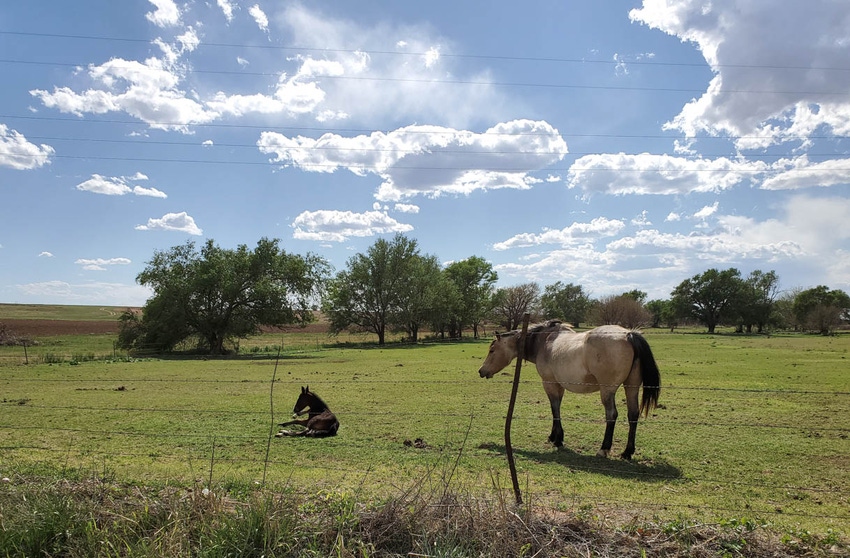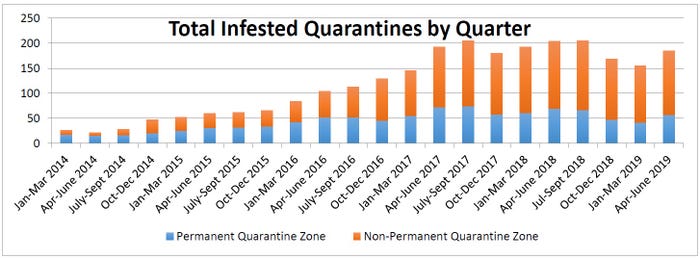
Late summer’s lingering heat across much of south Texas poses health risks for humans, livestock, equine and wildlife all across the state. But a slow cooling trend in the northern and central reaches of the state is helping to curb some animal health concerns.
Friday, Sept.12, the Texas Animal Health Commission issued a Texas Situational Update (#10) on summer’s outbreak of Vesicular Stomatitis (VSV) in equine, mostly limited to the central upper two- thirds of the state, beginning in Wichita County on the Texas-Oklahoma line, as far west as Val Verde County, east as far as Hopkins County, and as far south as Gonzales and Guadalupe Counties.
All total this year, 37 Texas counties were quarantined for VSV, but of the 171 premises quarantined, 170 have been released. According to TAHC Situational Update #10, one suspect VSV case leaves Ellis County the only county under a temporary quarantine order as of this writing.
According to TAHC, equine and cattle owners need to know:
VSV is a viral disease that primarily affects horses and cattle.
In the past decade, southwestern and western states have experienced a number of VSV outbreaks. Outbreaks usually occur during the warmer months, often along waterways.
VSV normally has an incubation period of 2 to 8 days before the infected animal develops blisters that swell and burst, leaving painful sores. The virus can be transmitted through direct contact with infected animals or by blood-feeding insects.
If VSV is confirmed, infected animals are quarantined for 14 days after clinical signs of lesions are observed. This short-term quarantine helps prevent movement of animals and the spread of the disease to other premises, fairs or markets.
Texas Fever Tick Update
The lingering summer heat in South Texas is cause for concern over the migration of fever ticks from the Texas Permanent Quarantine Zone (PQZ) located along a stretch of the lower Rio Grande Valley on the Texas-Mexico border.
For at least five years running, TAHC and USDA-APHIS officials have been battling the advancement of fever ticks, known scientifically as Rhipicephalus (formerly Boophilus) annulatus and R. microplus, which migrate on domestic cattle and wildlife from the PQZ north and eastward out of the zone into other Texas counties.
The latest available update from TAHC on fever ticks (The Fever Tick Situation Report) was issued July 31 and noted nearly a million acres of South Texas cattle country have been quarantined since the outbreak began. In all, 221,286 acres are included in the PQZ and an additional 775,883 acres have been placed under Non-Permanent Quarantine (NPQZ). All told, 2,835 quarantined premises were being monitored for fever ticks at some point during the year.
t
In response to questions posed by Southwest Farm Press, TAHC made available a chart listing total infested quarantines by quarter dating back to the first quarter of 2014.
TAHC warns the Babesia organism attacks and destroys red blood cells, causing acute anemia, high fever, and enlargement of the spleen and liver, ultimately resulting in death for up to 90 percent of susceptible cattle.
The fever tick has been a threat to American agriculture for generations. The disease caused enormous economic losses to the U.S. cattle industry in the late 1800s and early 1900s. The TAHC and the USDA-APHIS Veterinary Services division work together to protect the state and nation from the pest and the threat it presents for the cattle industry.
The agencies have been fighting Cattle Fever ticks outside of the PQZ for several years, most recently in late July when ticks were discovered on an animal at a Jim Wells County at a voluntary inspection program dipping vat.
“Anytime you find a tick on your animal that you do not recognize as being common, it is important to take that [tick] to state animal health officials, call your local veterinarian, your local Extension agent, or get in touch with the Texas Animal Health Commission in Austin and send it to them for testing,” advises Texas AgriLife Extension cattle specialist Joe Paschal in Corpus Christi.
He warns that fever ticks can also affect horses and deer, which can serve as carriers of the ticks.
Tropical rains creating late-season mosquito haven
A late blossoming tropical weather season on the Texas coast has been bringing regular and at times heavy rain showers to parts of Texas over the last 10 days, a welcome relief from dry conditions that have elevated drought warnings for some South Texas counties, but also bringing concerns of increased mosquito infestations.
Animal and human health can be affected by mosquito-borne diseases and many communities are alerting residents and visitors of the dangers and advising to restrict outdoor activities in early morning and evening when most mosquitoes swarm. In addition to past outbreaks of West Nile Virus and West Nile Virus Fever carried by mosquitoes, the Zika virus is another concern. While no reports of potentially deadly Eastern Equine Encephalitis (EEE) have been reported in Texas since 2015, cases of the disease have been confirmed in both Michigan and Massachusetts where two people, a farmer and a young girl, died from infections earlier this summer.
Horses, birds and rodents can be carriers of the disease, but mosquitoes are the number one transmitter of EEE to humans. In all cases, health officials recommend monitoring and removing standing water around the home and farm and to use a repellent containing DEET to avoid mosquitos when working or playing outdoors during rainy seasons.
EEE in horses generally results in death.
About the Author(s)
You May Also Like






